CYW319 Business Plan Essay: Social Enterprise and Community Care
VerifiedAdded on 2022/08/27
|17
|4566
|16
Essay
AI Summary
This essay provides a critical understanding of social entrepreneurship within the context of community-based practice, emphasizing empowerment, equality, and diversity. It delves into the core principles of social entrepreneurship, its advantages, and its application in addressing social issues. The essay examines the theoretical influences on social entrepreneurship, including motivational theories, emotional resilience, social and community enterprise models, and entrepreneurial leadership. It also explores the practical application of these concepts by proposing a community-based social enterprise – a hair salon for people over 55 in Dunstable, Bedfordshire – designed to combat social isolation and enhance the well-being of the elderly. The essay concludes by highlighting the importance of social entrepreneurship in addressing community needs and fostering positive social change. This essay aligns with the CYW319 course and focuses on developing entrepreneurial skills and creating a business plan for a community-based practice.

Running head: ESSAY
Health and social care
Name of the Student
Name of the University
Author Note
Health and social care
Name of the Student
Name of the University
Author Note
Paraphrase This Document
Need a fresh take? Get an instant paraphrase of this document with our AI Paraphraser
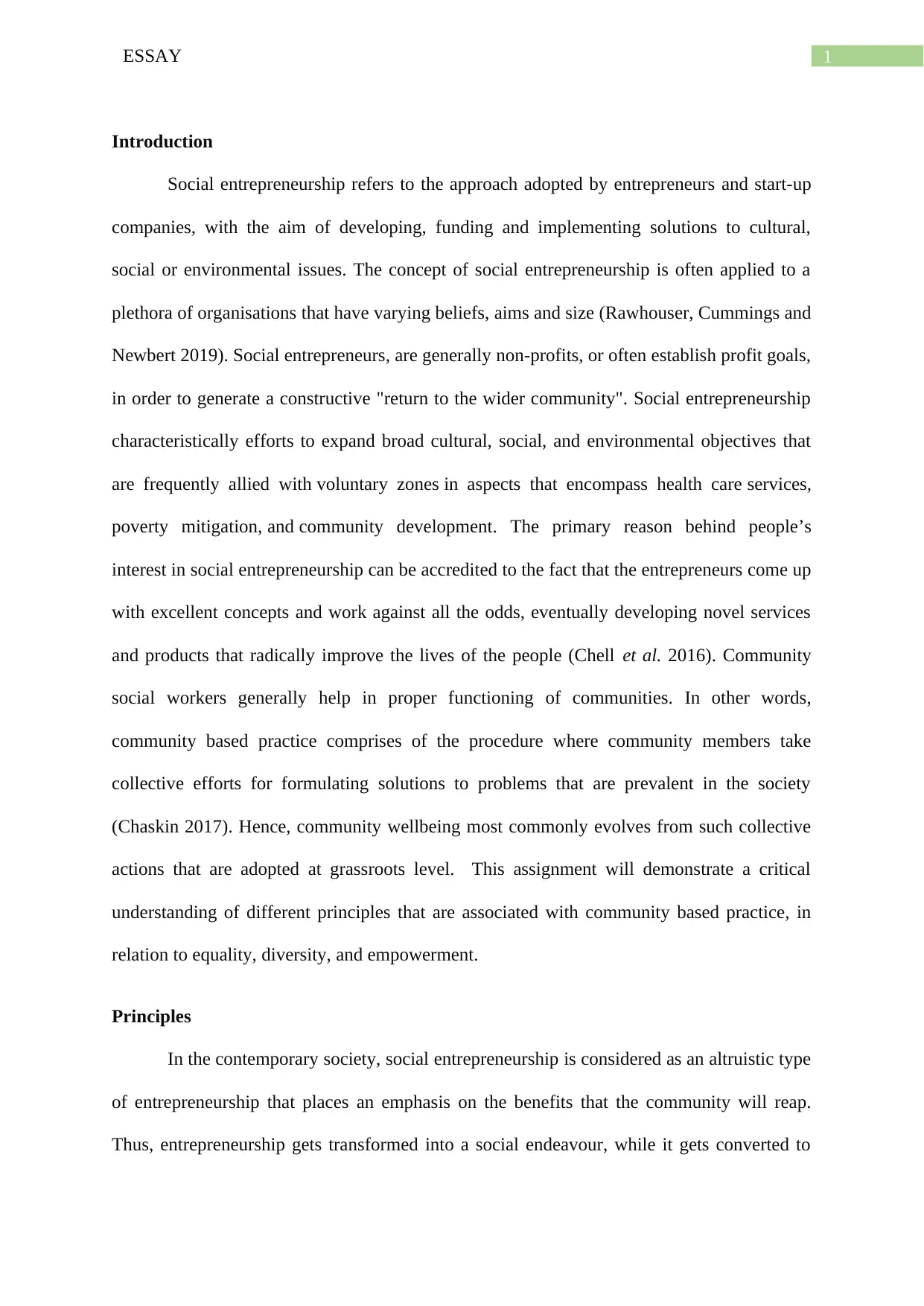
1ESSAY
Introduction
Social entrepreneurship refers to the approach adopted by entrepreneurs and start-up
companies, with the aim of developing, funding and implementing solutions to cultural,
social or environmental issues. The concept of social entrepreneurship is often applied to a
plethora of organisations that have varying beliefs, aims and size (Rawhouser, Cummings and
Newbert 2019). Social entrepreneurs, are generally non-profits, or often establish profit goals,
in order to generate a constructive "return to the wider community". Social entrepreneurship
characteristically efforts to expand broad cultural, social, and environmental objectives that
are frequently allied with voluntary zones in aspects that encompass health care services,
poverty mitigation, and community development. The primary reason behind people’s
interest in social entrepreneurship can be accredited to the fact that the entrepreneurs come up
with excellent concepts and work against all the odds, eventually developing novel services
and products that radically improve the lives of the people (Chell et al. 2016). Community
social workers generally help in proper functioning of communities. In other words,
community based practice comprises of the procedure where community members take
collective efforts for formulating solutions to problems that are prevalent in the society
(Chaskin 2017). Hence, community wellbeing most commonly evolves from such collective
actions that are adopted at grassroots level. This assignment will demonstrate a critical
understanding of different principles that are associated with community based practice, in
relation to equality, diversity, and empowerment.
Principles
In the contemporary society, social entrepreneurship is considered as an altruistic type
of entrepreneurship that places an emphasis on the benefits that the community will reap.
Thus, entrepreneurship gets transformed into a social endeavour, while it gets converted to
Introduction
Social entrepreneurship refers to the approach adopted by entrepreneurs and start-up
companies, with the aim of developing, funding and implementing solutions to cultural,
social or environmental issues. The concept of social entrepreneurship is often applied to a
plethora of organisations that have varying beliefs, aims and size (Rawhouser, Cummings and
Newbert 2019). Social entrepreneurs, are generally non-profits, or often establish profit goals,
in order to generate a constructive "return to the wider community". Social entrepreneurship
characteristically efforts to expand broad cultural, social, and environmental objectives that
are frequently allied with voluntary zones in aspects that encompass health care services,
poverty mitigation, and community development. The primary reason behind people’s
interest in social entrepreneurship can be accredited to the fact that the entrepreneurs come up
with excellent concepts and work against all the odds, eventually developing novel services
and products that radically improve the lives of the people (Chell et al. 2016). Community
social workers generally help in proper functioning of communities. In other words,
community based practice comprises of the procedure where community members take
collective efforts for formulating solutions to problems that are prevalent in the society
(Chaskin 2017). Hence, community wellbeing most commonly evolves from such collective
actions that are adopted at grassroots level. This assignment will demonstrate a critical
understanding of different principles that are associated with community based practice, in
relation to equality, diversity, and empowerment.
Principles
In the contemporary society, social entrepreneurship is considered as an altruistic type
of entrepreneurship that places an emphasis on the benefits that the community will reap.
Thus, entrepreneurship gets transformed into a social endeavour, while it gets converted to

2ESSAY
social capital, in a manner that creates a positive impact on the society. It is predominantly
considered advantageous owing to the fact that its success entirely depends on a range of
factors associated to social impact that outmoded corporate businesses fail to prioritize
(Krasniqi 2019). Hence, social entrepreneurs identify instant social problems, nonetheless
also pursue to comprehend the wider context of a problem that traverses fields, disciplines,
and theories. Social entrepreneurship is based on four major ideas that are namely, (i)
financial feasibility of the project, (ii) environmental and social objectives, (iii) governance,
and (iv) social distribution.
Environmental or social goals have been identified imperative since they focus on
developing social value and also highlight the objective of entrepreneurship for both the
community and the team. These goals are predominantly focused on enhancing the world,
and range from increasing access to health and social care services to reducing
unemployment or encouraging organic food consumption. According to Kummitha (2017)
similar to any sustainable commercial activity, these projects must address an actual demand
formerly recognised in any market study. Furthermore, participation forms a core component
of social entrepreneurship since it is based on individual interests and shared decision
making. While present-day community based health and social care programs fail to rigidly
conform to any predefined standards, most programs are grounded on a plethora of
significant assumptions. Some core aspects of community practice are empowerment,
diversity, equality, and intersectoral collaboration (Kral and Kidd 2018).
Community empowerment refers to the procedure that helps community members
gain an influence over their lives. Communities typically comprise of groups of individuals
sharing common concerns, benefits, or individualities. Through empowerment, individuals
are capable to control the issues and choices that describe their lives. By snowballing their
possessions and building their capabilities, they can consequently widen their networks
social capital, in a manner that creates a positive impact on the society. It is predominantly
considered advantageous owing to the fact that its success entirely depends on a range of
factors associated to social impact that outmoded corporate businesses fail to prioritize
(Krasniqi 2019). Hence, social entrepreneurs identify instant social problems, nonetheless
also pursue to comprehend the wider context of a problem that traverses fields, disciplines,
and theories. Social entrepreneurship is based on four major ideas that are namely, (i)
financial feasibility of the project, (ii) environmental and social objectives, (iii) governance,
and (iv) social distribution.
Environmental or social goals have been identified imperative since they focus on
developing social value and also highlight the objective of entrepreneurship for both the
community and the team. These goals are predominantly focused on enhancing the world,
and range from increasing access to health and social care services to reducing
unemployment or encouraging organic food consumption. According to Kummitha (2017)
similar to any sustainable commercial activity, these projects must address an actual demand
formerly recognised in any market study. Furthermore, participation forms a core component
of social entrepreneurship since it is based on individual interests and shared decision
making. While present-day community based health and social care programs fail to rigidly
conform to any predefined standards, most programs are grounded on a plethora of
significant assumptions. Some core aspects of community practice are empowerment,
diversity, equality, and intersectoral collaboration (Kral and Kidd 2018).
Community empowerment refers to the procedure that helps community members
gain an influence over their lives. Communities typically comprise of groups of individuals
sharing common concerns, benefits, or individualities. Through empowerment, individuals
are capable to control the issues and choices that describe their lives. By snowballing their
possessions and building their capabilities, they can consequently widen their networks
⊘ This is a preview!⊘
Do you want full access?
Subscribe today to unlock all pages.

Trusted by 1+ million students worldwide
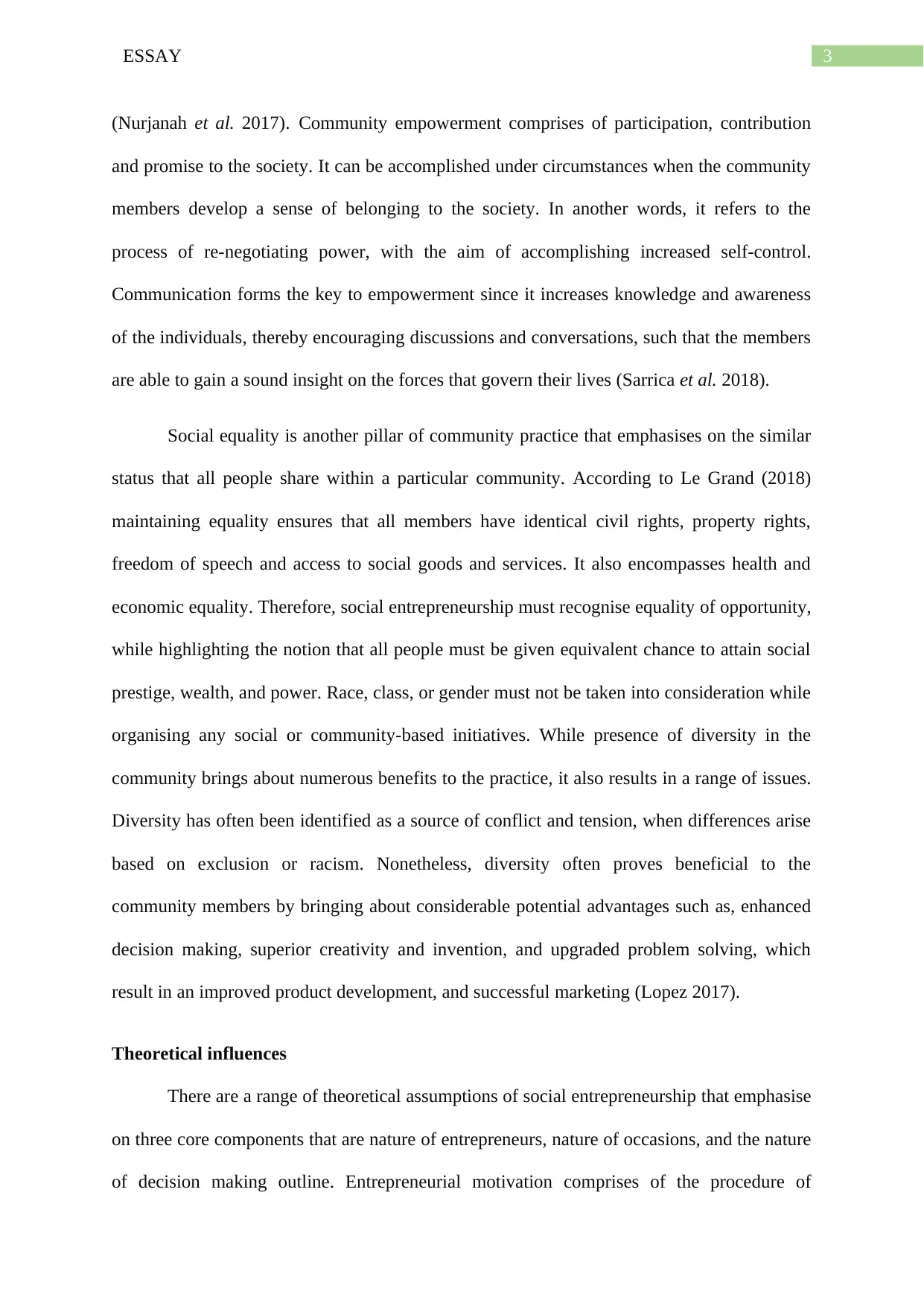
3ESSAY
(Nurjanah et al. 2017). Community empowerment comprises of participation, contribution
and promise to the society. It can be accomplished under circumstances when the community
members develop a sense of belonging to the society. In another words, it refers to the
process of re-negotiating power, with the aim of accomplishing increased self-control.
Communication forms the key to empowerment since it increases knowledge and awareness
of the individuals, thereby encouraging discussions and conversations, such that the members
are able to gain a sound insight on the forces that govern their lives (Sarrica et al. 2018).
Social equality is another pillar of community practice that emphasises on the similar
status that all people share within a particular community. According to Le Grand (2018)
maintaining equality ensures that all members have identical civil rights, property rights,
freedom of speech and access to social goods and services. It also encompasses health and
economic equality. Therefore, social entrepreneurship must recognise equality of opportunity,
while highlighting the notion that all people must be given equivalent chance to attain social
prestige, wealth, and power. Race, class, or gender must not be taken into consideration while
organising any social or community-based initiatives. While presence of diversity in the
community brings about numerous benefits to the practice, it also results in a range of issues.
Diversity has often been identified as a source of conflict and tension, when differences arise
based on exclusion or racism. Nonetheless, diversity often proves beneficial to the
community members by bringing about considerable potential advantages such as, enhanced
decision making, superior creativity and invention, and upgraded problem solving, which
result in an improved product development, and successful marketing (Lopez 2017).
Theoretical influences
There are a range of theoretical assumptions of social entrepreneurship that emphasise
on three core components that are nature of entrepreneurs, nature of occasions, and the nature
of decision making outline. Entrepreneurial motivation comprises of the procedure of
(Nurjanah et al. 2017). Community empowerment comprises of participation, contribution
and promise to the society. It can be accomplished under circumstances when the community
members develop a sense of belonging to the society. In another words, it refers to the
process of re-negotiating power, with the aim of accomplishing increased self-control.
Communication forms the key to empowerment since it increases knowledge and awareness
of the individuals, thereby encouraging discussions and conversations, such that the members
are able to gain a sound insight on the forces that govern their lives (Sarrica et al. 2018).
Social equality is another pillar of community practice that emphasises on the similar
status that all people share within a particular community. According to Le Grand (2018)
maintaining equality ensures that all members have identical civil rights, property rights,
freedom of speech and access to social goods and services. It also encompasses health and
economic equality. Therefore, social entrepreneurship must recognise equality of opportunity,
while highlighting the notion that all people must be given equivalent chance to attain social
prestige, wealth, and power. Race, class, or gender must not be taken into consideration while
organising any social or community-based initiatives. While presence of diversity in the
community brings about numerous benefits to the practice, it also results in a range of issues.
Diversity has often been identified as a source of conflict and tension, when differences arise
based on exclusion or racism. Nonetheless, diversity often proves beneficial to the
community members by bringing about considerable potential advantages such as, enhanced
decision making, superior creativity and invention, and upgraded problem solving, which
result in an improved product development, and successful marketing (Lopez 2017).
Theoretical influences
There are a range of theoretical assumptions of social entrepreneurship that emphasise
on three core components that are nature of entrepreneurs, nature of occasions, and the nature
of decision making outline. Entrepreneurial motivation comprises of the procedure of
Paraphrase This Document
Need a fresh take? Get an instant paraphrase of this document with our AI Paraphraser
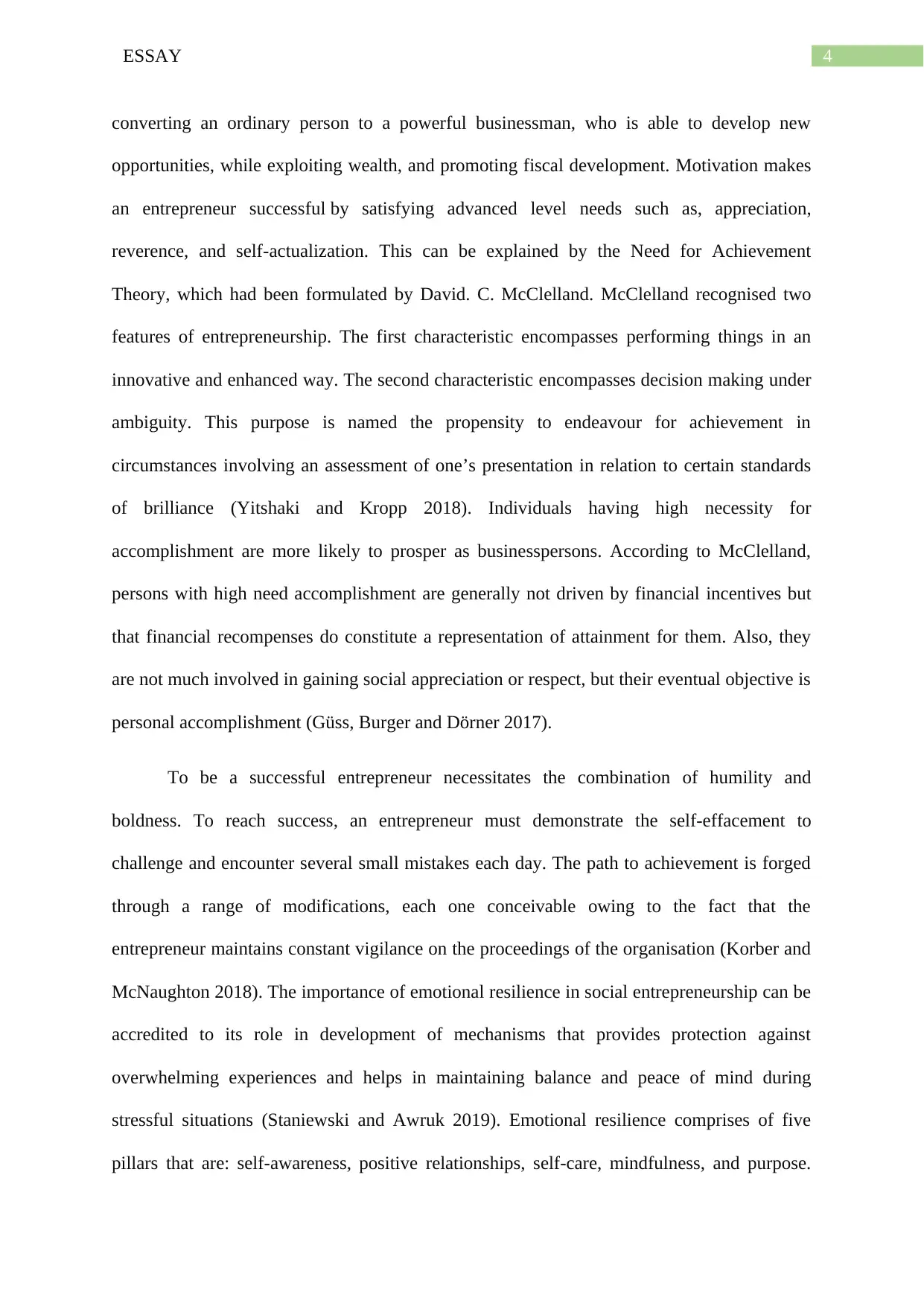
4ESSAY
converting an ordinary person to a powerful businessman, who is able to develop new
opportunities, while exploiting wealth, and promoting fiscal development. Motivation makes
an entrepreneur successful by satisfying advanced level needs such as, appreciation,
reverence, and self-actualization. This can be explained by the Need for Achievement
Theory, which had been formulated by David. C. McClelland. McClelland recognised two
features of entrepreneurship. The first characteristic encompasses performing things in an
innovative and enhanced way. The second characteristic encompasses decision making under
ambiguity. This purpose is named the propensity to endeavour for achievement in
circumstances involving an assessment of one’s presentation in relation to certain standards
of brilliance (Yitshaki and Kropp 2018). Individuals having high necessity for
accomplishment are more likely to prosper as businesspersons. According to McClelland,
persons with high need accomplishment are generally not driven by financial incentives but
that financial recompenses do constitute a representation of attainment for them. Also, they
are not much involved in gaining social appreciation or respect, but their eventual objective is
personal accomplishment (Güss, Burger and Dörner 2017).
To be a successful entrepreneur necessitates the combination of humility and
boldness. To reach success, an entrepreneur must demonstrate the self-effacement to
challenge and encounter several small mistakes each day. The path to achievement is forged
through a range of modifications, each one conceivable owing to the fact that the
entrepreneur maintains constant vigilance on the proceedings of the organisation (Korber and
McNaughton 2018). The importance of emotional resilience in social entrepreneurship can be
accredited to its role in development of mechanisms that provides protection against
overwhelming experiences and helps in maintaining balance and peace of mind during
stressful situations (Staniewski and Awruk 2019). Emotional resilience comprises of five
pillars that are: self-awareness, positive relationships, self-care, mindfulness, and purpose.
converting an ordinary person to a powerful businessman, who is able to develop new
opportunities, while exploiting wealth, and promoting fiscal development. Motivation makes
an entrepreneur successful by satisfying advanced level needs such as, appreciation,
reverence, and self-actualization. This can be explained by the Need for Achievement
Theory, which had been formulated by David. C. McClelland. McClelland recognised two
features of entrepreneurship. The first characteristic encompasses performing things in an
innovative and enhanced way. The second characteristic encompasses decision making under
ambiguity. This purpose is named the propensity to endeavour for achievement in
circumstances involving an assessment of one’s presentation in relation to certain standards
of brilliance (Yitshaki and Kropp 2018). Individuals having high necessity for
accomplishment are more likely to prosper as businesspersons. According to McClelland,
persons with high need accomplishment are generally not driven by financial incentives but
that financial recompenses do constitute a representation of attainment for them. Also, they
are not much involved in gaining social appreciation or respect, but their eventual objective is
personal accomplishment (Güss, Burger and Dörner 2017).
To be a successful entrepreneur necessitates the combination of humility and
boldness. To reach success, an entrepreneur must demonstrate the self-effacement to
challenge and encounter several small mistakes each day. The path to achievement is forged
through a range of modifications, each one conceivable owing to the fact that the
entrepreneur maintains constant vigilance on the proceedings of the organisation (Korber and
McNaughton 2018). The importance of emotional resilience in social entrepreneurship can be
accredited to its role in development of mechanisms that provides protection against
overwhelming experiences and helps in maintaining balance and peace of mind during
stressful situations (Staniewski and Awruk 2019). Emotional resilience comprises of five
pillars that are: self-awareness, positive relationships, self-care, mindfulness, and purpose.

5ESSAY
Resilient entrepreneurs have adequate time to think before acting and are generally good at
planning. This helps in prioritising work and accomplishing the anticipated outcomes
(Kinman and Grant 2016).
The basic idea of social and community enterprise developed during the late 70s as a
substitute to private cooperatives, businesses, and public enterprises. The three aspects that
govern such enterprises are (i) generating social wealth, (ii) trading and monetarily viable
individuality, and (iii) functioning in environmentally accountable manners. The institutional
theory can be used to explain the fact that social enterprise models are generally adopted by
non-profits since these models are widely accepted and legitimised (Su, Zhai and Karlsson
2017). Entrepreneurs who fail to notice the institutional judgement of their social settings are
subjected to failure since they are often considered dishonest and undeserving support. This
in turn is associated to "liability of newness", where the threat of failures is comparatively
greater during the initial years of an association. Under circumstances when the young
organizations lack acceptability, they might not obtain the much needed assistance of their
stakeholders (Rutherford et al. 2018). In other words, the primary hypothesis of this theory is
that culturally fluctuating social forces directly govern the entrepreneurial accomplishment
more than financial efficiency, consequently, social entrepreneurs must take efforts to align
their policies with the standards and guidelines of their business with that of the host
institutions.
Most commonly, entrepreneurs work in social networks for advancing their ventures
and ensuring continuous success and development. From the perspective of a social network
theory, entrepreneurship is considered associated to the act of enduring social associations.
Social capital is described as the worth of project initiators’ network resources. The networks
commonly act in the form of alternates for investment capital (Liu et al. 2017). The ability of
an entrepreneur to identify prospects is principally allied their aptitude to gain access to
Resilient entrepreneurs have adequate time to think before acting and are generally good at
planning. This helps in prioritising work and accomplishing the anticipated outcomes
(Kinman and Grant 2016).
The basic idea of social and community enterprise developed during the late 70s as a
substitute to private cooperatives, businesses, and public enterprises. The three aspects that
govern such enterprises are (i) generating social wealth, (ii) trading and monetarily viable
individuality, and (iii) functioning in environmentally accountable manners. The institutional
theory can be used to explain the fact that social enterprise models are generally adopted by
non-profits since these models are widely accepted and legitimised (Su, Zhai and Karlsson
2017). Entrepreneurs who fail to notice the institutional judgement of their social settings are
subjected to failure since they are often considered dishonest and undeserving support. This
in turn is associated to "liability of newness", where the threat of failures is comparatively
greater during the initial years of an association. Under circumstances when the young
organizations lack acceptability, they might not obtain the much needed assistance of their
stakeholders (Rutherford et al. 2018). In other words, the primary hypothesis of this theory is
that culturally fluctuating social forces directly govern the entrepreneurial accomplishment
more than financial efficiency, consequently, social entrepreneurs must take efforts to align
their policies with the standards and guidelines of their business with that of the host
institutions.
Most commonly, entrepreneurs work in social networks for advancing their ventures
and ensuring continuous success and development. From the perspective of a social network
theory, entrepreneurship is considered associated to the act of enduring social associations.
Social capital is described as the worth of project initiators’ network resources. The networks
commonly act in the form of alternates for investment capital (Liu et al. 2017). The ability of
an entrepreneur to identify prospects is principally allied their aptitude to gain access to
⊘ This is a preview!⊘
Do you want full access?
Subscribe today to unlock all pages.

Trusted by 1+ million students worldwide
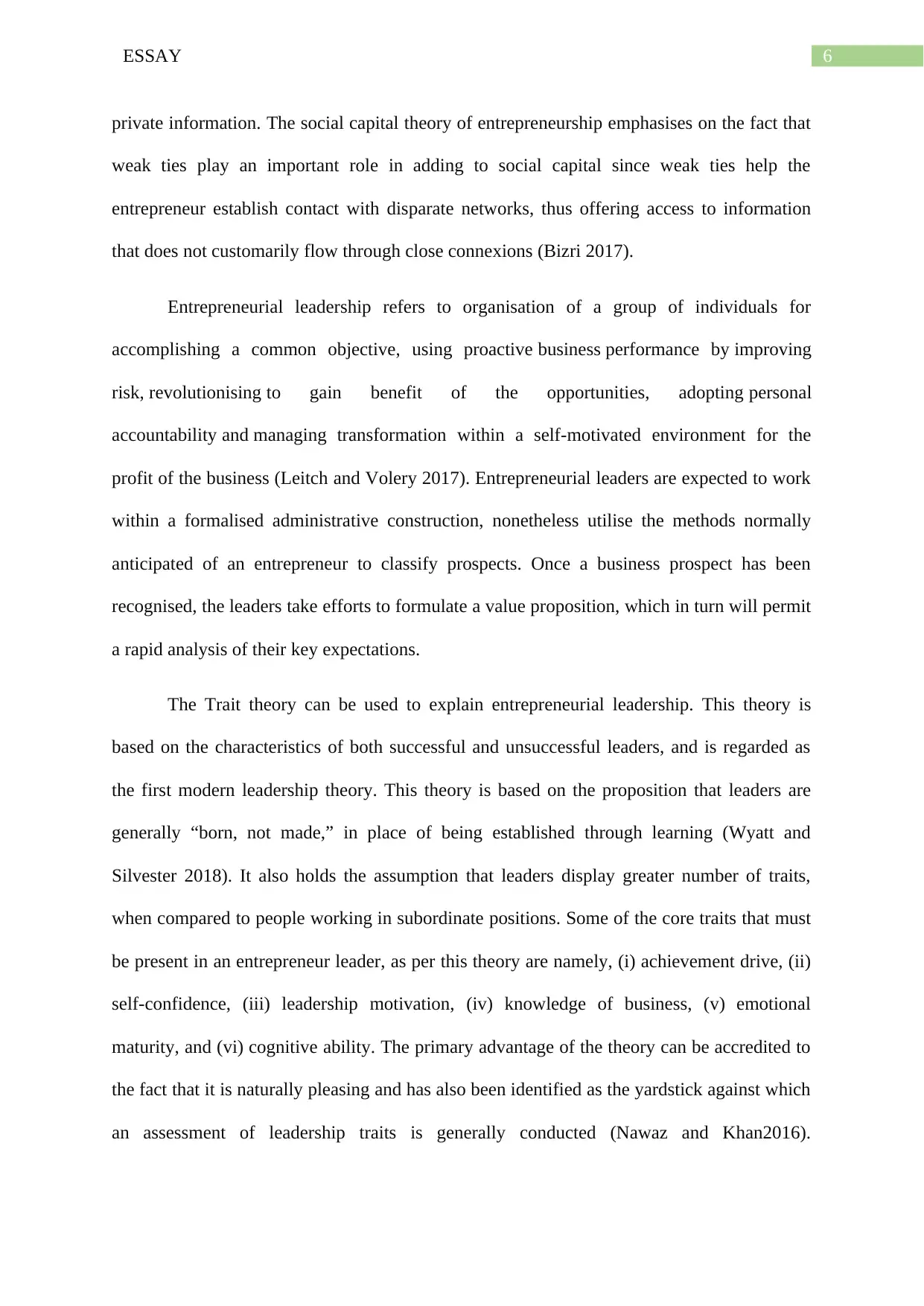
6ESSAY
private information. The social capital theory of entrepreneurship emphasises on the fact that
weak ties play an important role in adding to social capital since weak ties help the
entrepreneur establish contact with disparate networks, thus offering access to information
that does not customarily flow through close connexions (Bizri 2017).
Entrepreneurial leadership refers to organisation of a group of individuals for
accomplishing a common objective, using proactive business performance by improving
risk, revolutionising to gain benefit of the opportunities, adopting personal
accountability and managing transformation within a self-motivated environment for the
profit of the business (Leitch and Volery 2017). Entrepreneurial leaders are expected to work
within a formalised administrative construction, nonetheless utilise the methods normally
anticipated of an entrepreneur to classify prospects. Once a business prospect has been
recognised, the leaders take efforts to formulate a value proposition, which in turn will permit
a rapid analysis of their key expectations.
The Trait theory can be used to explain entrepreneurial leadership. This theory is
based on the characteristics of both successful and unsuccessful leaders, and is regarded as
the first modern leadership theory. This theory is based on the proposition that leaders are
generally “born, not made,” in place of being established through learning (Wyatt and
Silvester 2018). It also holds the assumption that leaders display greater number of traits,
when compared to people working in subordinate positions. Some of the core traits that must
be present in an entrepreneur leader, as per this theory are namely, (i) achievement drive, (ii)
self-confidence, (iii) leadership motivation, (iv) knowledge of business, (v) emotional
maturity, and (vi) cognitive ability. The primary advantage of the theory can be accredited to
the fact that it is naturally pleasing and has also been identified as the yardstick against which
an assessment of leadership traits is generally conducted (Nawaz and Khan2016).
private information. The social capital theory of entrepreneurship emphasises on the fact that
weak ties play an important role in adding to social capital since weak ties help the
entrepreneur establish contact with disparate networks, thus offering access to information
that does not customarily flow through close connexions (Bizri 2017).
Entrepreneurial leadership refers to organisation of a group of individuals for
accomplishing a common objective, using proactive business performance by improving
risk, revolutionising to gain benefit of the opportunities, adopting personal
accountability and managing transformation within a self-motivated environment for the
profit of the business (Leitch and Volery 2017). Entrepreneurial leaders are expected to work
within a formalised administrative construction, nonetheless utilise the methods normally
anticipated of an entrepreneur to classify prospects. Once a business prospect has been
recognised, the leaders take efforts to formulate a value proposition, which in turn will permit
a rapid analysis of their key expectations.
The Trait theory can be used to explain entrepreneurial leadership. This theory is
based on the characteristics of both successful and unsuccessful leaders, and is regarded as
the first modern leadership theory. This theory is based on the proposition that leaders are
generally “born, not made,” in place of being established through learning (Wyatt and
Silvester 2018). It also holds the assumption that leaders display greater number of traits,
when compared to people working in subordinate positions. Some of the core traits that must
be present in an entrepreneur leader, as per this theory are namely, (i) achievement drive, (ii)
self-confidence, (iii) leadership motivation, (iv) knowledge of business, (v) emotional
maturity, and (vi) cognitive ability. The primary advantage of the theory can be accredited to
the fact that it is naturally pleasing and has also been identified as the yardstick against which
an assessment of leadership traits is generally conducted (Nawaz and Khan2016).
Paraphrase This Document
Need a fresh take? Get an instant paraphrase of this document with our AI Paraphraser
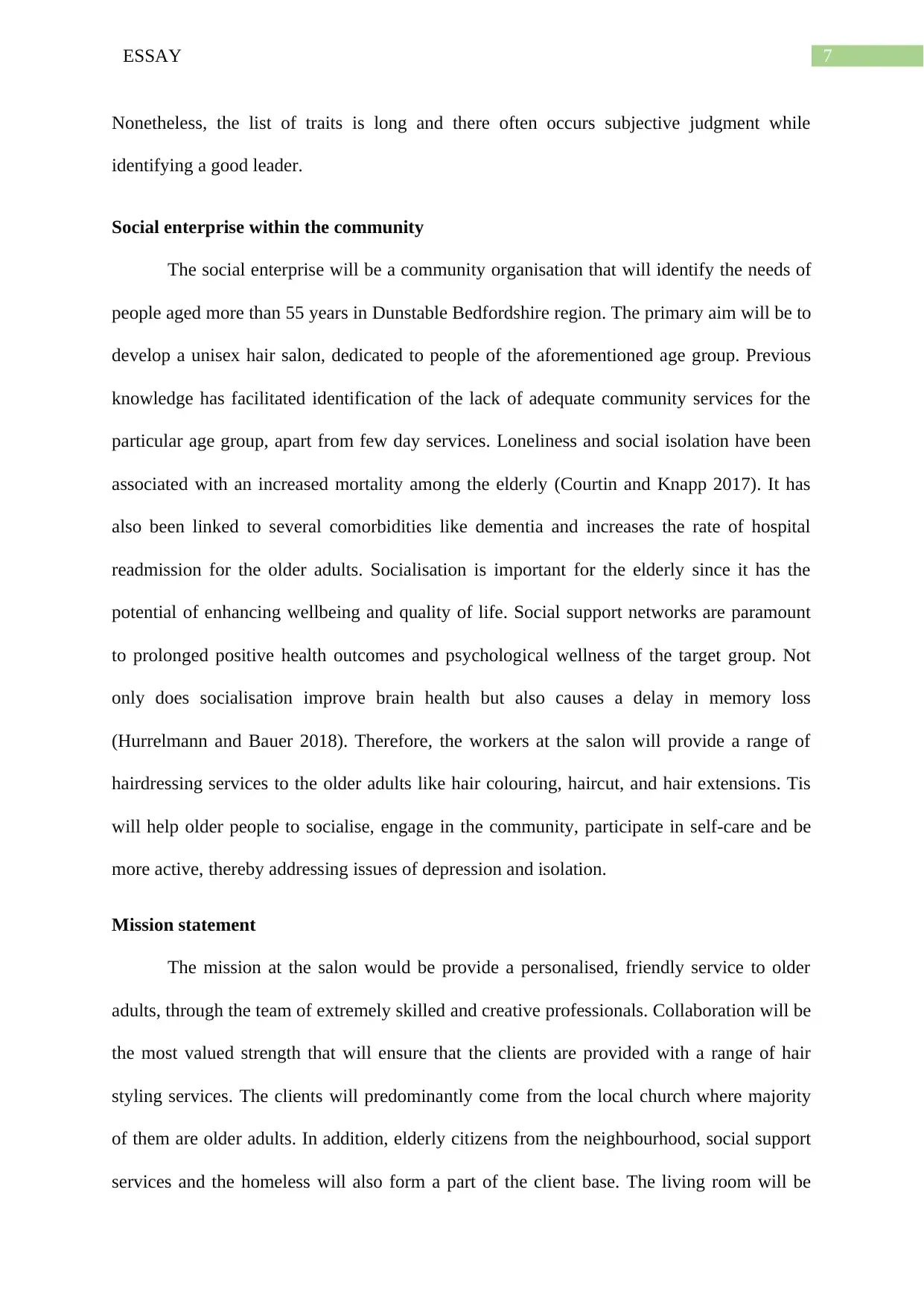
7ESSAY
Nonetheless, the list of traits is long and there often occurs subjective judgment while
identifying a good leader.
Social enterprise within the community
The social enterprise will be a community organisation that will identify the needs of
people aged more than 55 years in Dunstable Bedfordshire region. The primary aim will be to
develop a unisex hair salon, dedicated to people of the aforementioned age group. Previous
knowledge has facilitated identification of the lack of adequate community services for the
particular age group, apart from few day services. Loneliness and social isolation have been
associated with an increased mortality among the elderly (Courtin and Knapp 2017). It has
also been linked to several comorbidities like dementia and increases the rate of hospital
readmission for the older adults. Socialisation is important for the elderly since it has the
potential of enhancing wellbeing and quality of life. Social support networks are paramount
to prolonged positive health outcomes and psychological wellness of the target group. Not
only does socialisation improve brain health but also causes a delay in memory loss
(Hurrelmann and Bauer 2018). Therefore, the workers at the salon will provide a range of
hairdressing services to the older adults like hair colouring, haircut, and hair extensions. Tis
will help older people to socialise, engage in the community, participate in self-care and be
more active, thereby addressing issues of depression and isolation.
Mission statement
The mission at the salon would be provide a personalised, friendly service to older
adults, through the team of extremely skilled and creative professionals. Collaboration will be
the most valued strength that will ensure that the clients are provided with a range of hair
styling services. The clients will predominantly come from the local church where majority
of them are older adults. In addition, elderly citizens from the neighbourhood, social support
services and the homeless will also form a part of the client base. The living room will be
Nonetheless, the list of traits is long and there often occurs subjective judgment while
identifying a good leader.
Social enterprise within the community
The social enterprise will be a community organisation that will identify the needs of
people aged more than 55 years in Dunstable Bedfordshire region. The primary aim will be to
develop a unisex hair salon, dedicated to people of the aforementioned age group. Previous
knowledge has facilitated identification of the lack of adequate community services for the
particular age group, apart from few day services. Loneliness and social isolation have been
associated with an increased mortality among the elderly (Courtin and Knapp 2017). It has
also been linked to several comorbidities like dementia and increases the rate of hospital
readmission for the older adults. Socialisation is important for the elderly since it has the
potential of enhancing wellbeing and quality of life. Social support networks are paramount
to prolonged positive health outcomes and psychological wellness of the target group. Not
only does socialisation improve brain health but also causes a delay in memory loss
(Hurrelmann and Bauer 2018). Therefore, the workers at the salon will provide a range of
hairdressing services to the older adults like hair colouring, haircut, and hair extensions. Tis
will help older people to socialise, engage in the community, participate in self-care and be
more active, thereby addressing issues of depression and isolation.
Mission statement
The mission at the salon would be provide a personalised, friendly service to older
adults, through the team of extremely skilled and creative professionals. Collaboration will be
the most valued strength that will ensure that the clients are provided with a range of hair
styling services. The clients will predominantly come from the local church where majority
of them are older adults. In addition, elderly citizens from the neighbourhood, social support
services and the homeless will also form a part of the client base. The living room will be
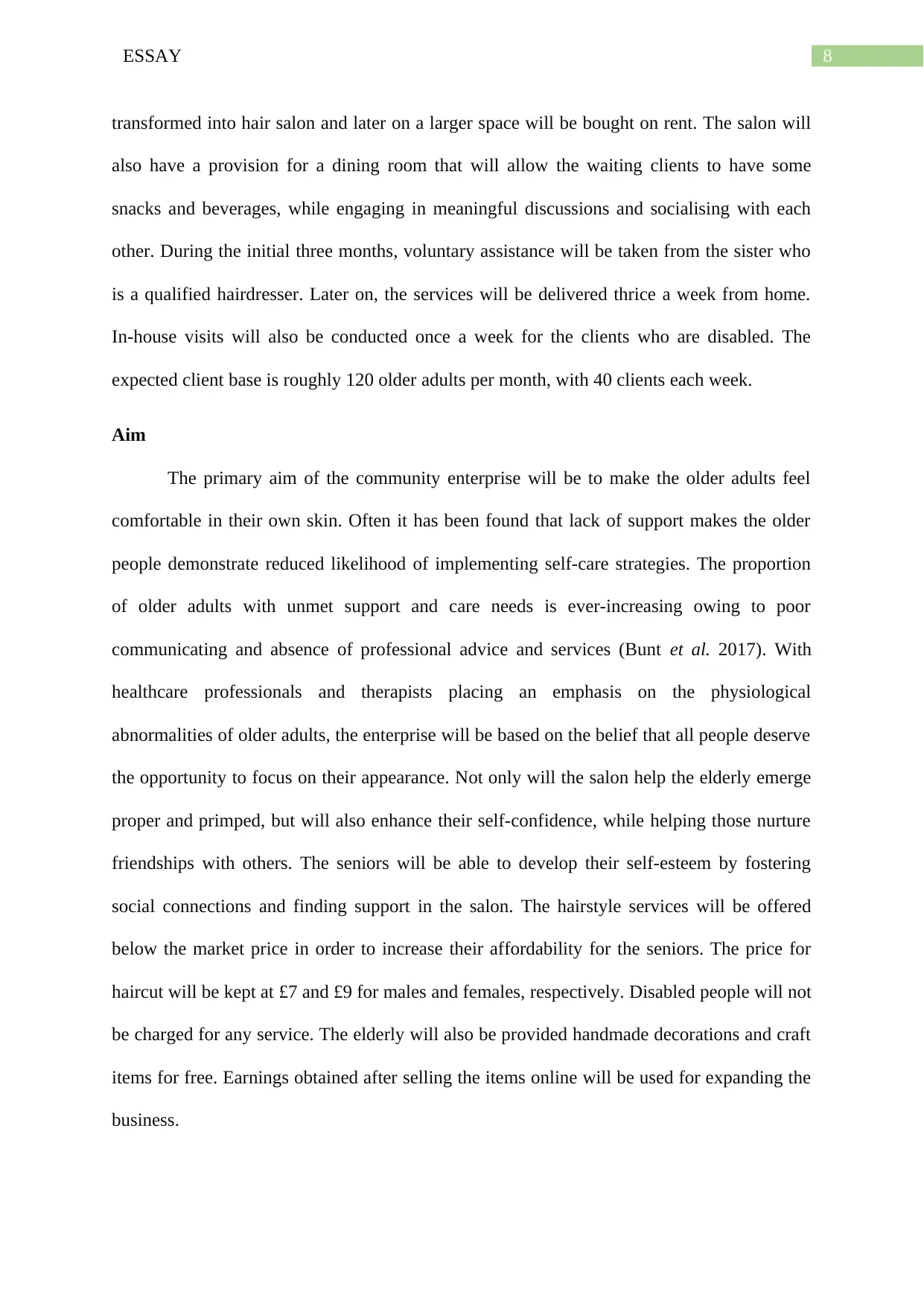
8ESSAY
transformed into hair salon and later on a larger space will be bought on rent. The salon will
also have a provision for a dining room that will allow the waiting clients to have some
snacks and beverages, while engaging in meaningful discussions and socialising with each
other. During the initial three months, voluntary assistance will be taken from the sister who
is a qualified hairdresser. Later on, the services will be delivered thrice a week from home.
In-house visits will also be conducted once a week for the clients who are disabled. The
expected client base is roughly 120 older adults per month, with 40 clients each week.
Aim
The primary aim of the community enterprise will be to make the older adults feel
comfortable in their own skin. Often it has been found that lack of support makes the older
people demonstrate reduced likelihood of implementing self-care strategies. The proportion
of older adults with unmet support and care needs is ever-increasing owing to poor
communicating and absence of professional advice and services (Bunt et al. 2017). With
healthcare professionals and therapists placing an emphasis on the physiological
abnormalities of older adults, the enterprise will be based on the belief that all people deserve
the opportunity to focus on their appearance. Not only will the salon help the elderly emerge
proper and primped, but will also enhance their self-confidence, while helping those nurture
friendships with others. The seniors will be able to develop their self-esteem by fostering
social connections and finding support in the salon. The hairstyle services will be offered
below the market price in order to increase their affordability for the seniors. The price for
haircut will be kept at £7 and £9 for males and females, respectively. Disabled people will not
be charged for any service. The elderly will also be provided handmade decorations and craft
items for free. Earnings obtained after selling the items online will be used for expanding the
business.
transformed into hair salon and later on a larger space will be bought on rent. The salon will
also have a provision for a dining room that will allow the waiting clients to have some
snacks and beverages, while engaging in meaningful discussions and socialising with each
other. During the initial three months, voluntary assistance will be taken from the sister who
is a qualified hairdresser. Later on, the services will be delivered thrice a week from home.
In-house visits will also be conducted once a week for the clients who are disabled. The
expected client base is roughly 120 older adults per month, with 40 clients each week.
Aim
The primary aim of the community enterprise will be to make the older adults feel
comfortable in their own skin. Often it has been found that lack of support makes the older
people demonstrate reduced likelihood of implementing self-care strategies. The proportion
of older adults with unmet support and care needs is ever-increasing owing to poor
communicating and absence of professional advice and services (Bunt et al. 2017). With
healthcare professionals and therapists placing an emphasis on the physiological
abnormalities of older adults, the enterprise will be based on the belief that all people deserve
the opportunity to focus on their appearance. Not only will the salon help the elderly emerge
proper and primped, but will also enhance their self-confidence, while helping those nurture
friendships with others. The seniors will be able to develop their self-esteem by fostering
social connections and finding support in the salon. The hairstyle services will be offered
below the market price in order to increase their affordability for the seniors. The price for
haircut will be kept at £7 and £9 for males and females, respectively. Disabled people will not
be charged for any service. The elderly will also be provided handmade decorations and craft
items for free. Earnings obtained after selling the items online will be used for expanding the
business.
⊘ This is a preview!⊘
Do you want full access?
Subscribe today to unlock all pages.

Trusted by 1+ million students worldwide
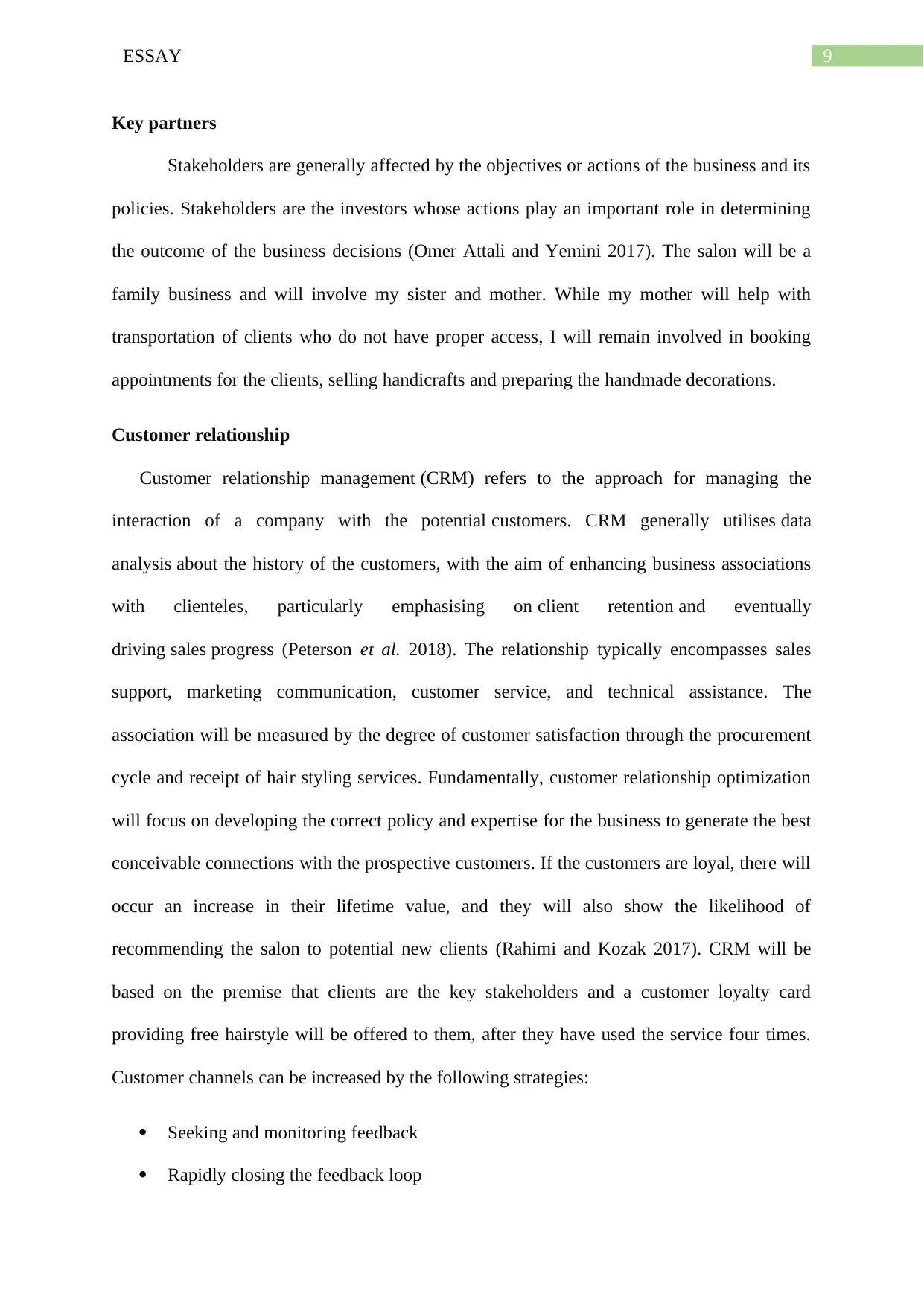
9ESSAY
Key partners
Stakeholders are generally affected by the objectives or actions of the business and its
policies. Stakeholders are the investors whose actions play an important role in determining
the outcome of the business decisions (Omer Attali and Yemini 2017). The salon will be a
family business and will involve my sister and mother. While my mother will help with
transportation of clients who do not have proper access, I will remain involved in booking
appointments for the clients, selling handicrafts and preparing the handmade decorations.
Customer relationship
Customer relationship management (CRM) refers to the approach for managing the
interaction of a company with the potential customers. CRM generally utilises data
analysis about the history of the customers, with the aim of enhancing business associations
with clienteles, particularly emphasising on client retention and eventually
driving sales progress (Peterson et al. 2018). The relationship typically encompasses sales
support, marketing communication, customer service, and technical assistance. The
association will be measured by the degree of customer satisfaction through the procurement
cycle and receipt of hair styling services. Fundamentally, customer relationship optimization
will focus on developing the correct policy and expertise for the business to generate the best
conceivable connections with the prospective customers. If the customers are loyal, there will
occur an increase in their lifetime value, and they will also show the likelihood of
recommending the salon to potential new clients (Rahimi and Kozak 2017). CRM will be
based on the premise that clients are the key stakeholders and a customer loyalty card
providing free hairstyle will be offered to them, after they have used the service four times.
Customer channels can be increased by the following strategies:
Seeking and monitoring feedback
Rapidly closing the feedback loop
Key partners
Stakeholders are generally affected by the objectives or actions of the business and its
policies. Stakeholders are the investors whose actions play an important role in determining
the outcome of the business decisions (Omer Attali and Yemini 2017). The salon will be a
family business and will involve my sister and mother. While my mother will help with
transportation of clients who do not have proper access, I will remain involved in booking
appointments for the clients, selling handicrafts and preparing the handmade decorations.
Customer relationship
Customer relationship management (CRM) refers to the approach for managing the
interaction of a company with the potential customers. CRM generally utilises data
analysis about the history of the customers, with the aim of enhancing business associations
with clienteles, particularly emphasising on client retention and eventually
driving sales progress (Peterson et al. 2018). The relationship typically encompasses sales
support, marketing communication, customer service, and technical assistance. The
association will be measured by the degree of customer satisfaction through the procurement
cycle and receipt of hair styling services. Fundamentally, customer relationship optimization
will focus on developing the correct policy and expertise for the business to generate the best
conceivable connections with the prospective customers. If the customers are loyal, there will
occur an increase in their lifetime value, and they will also show the likelihood of
recommending the salon to potential new clients (Rahimi and Kozak 2017). CRM will be
based on the premise that clients are the key stakeholders and a customer loyalty card
providing free hairstyle will be offered to them, after they have used the service four times.
Customer channels can be increased by the following strategies:
Seeking and monitoring feedback
Rapidly closing the feedback loop
Paraphrase This Document
Need a fresh take? Get an instant paraphrase of this document with our AI Paraphraser
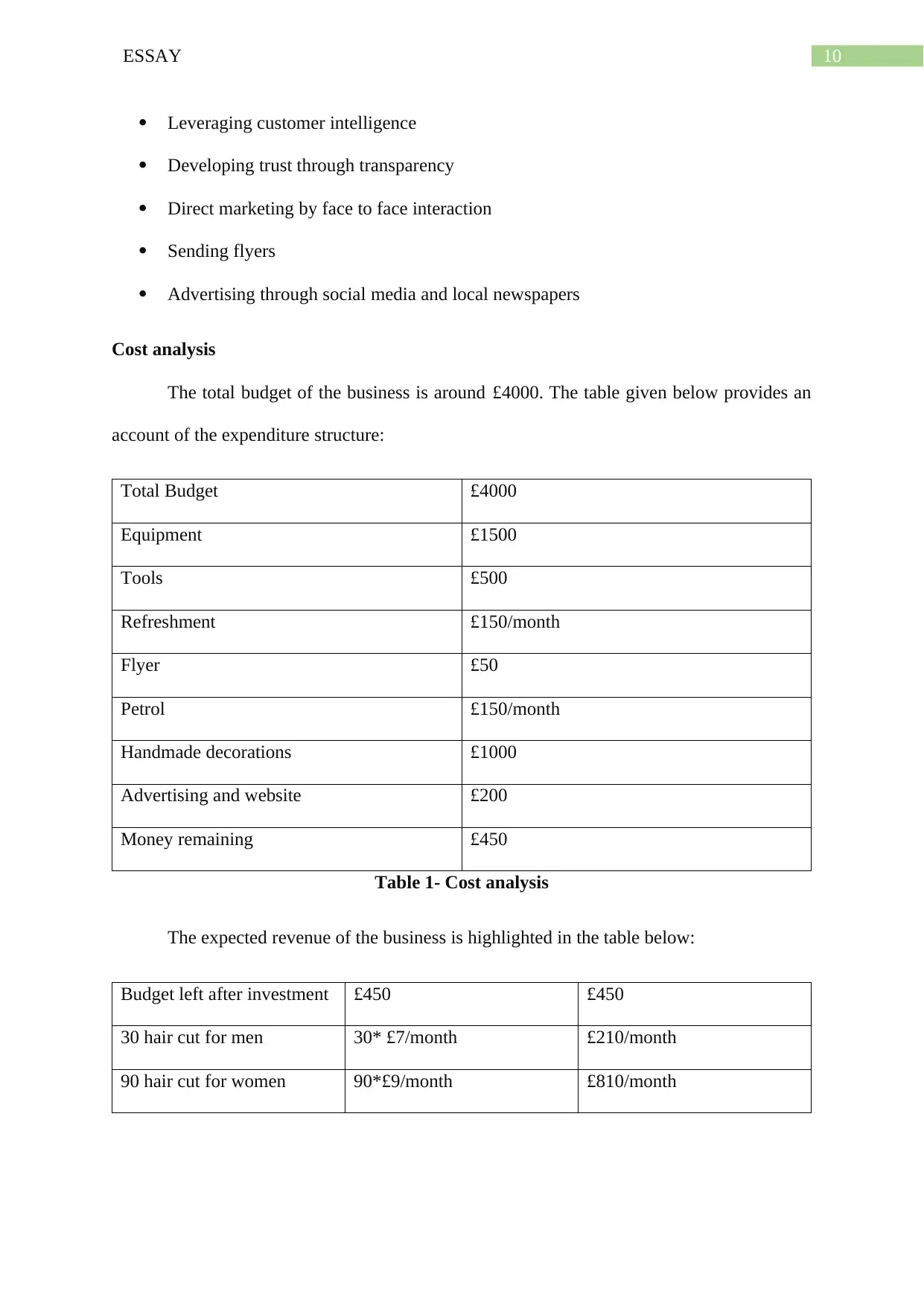
10ESSAY
Leveraging customer intelligence
Developing trust through transparency
Direct marketing by face to face interaction
Sending flyers
Advertising through social media and local newspapers
Cost analysis
The total budget of the business is around £4000. The table given below provides an
account of the expenditure structure:
Total Budget £4000
Equipment £1500
Tools £500
Refreshment £150/month
Flyer £50
Petrol £150/month
Handmade decorations £1000
Advertising and website £200
Money remaining £450
Table 1- Cost analysis
The expected revenue of the business is highlighted in the table below:
Budget left after investment £450 £450
30 hair cut for men 30* £7/month £210/month
90 hair cut for women 90*£9/month £810/month
Leveraging customer intelligence
Developing trust through transparency
Direct marketing by face to face interaction
Sending flyers
Advertising through social media and local newspapers
Cost analysis
The total budget of the business is around £4000. The table given below provides an
account of the expenditure structure:
Total Budget £4000
Equipment £1500
Tools £500
Refreshment £150/month
Flyer £50
Petrol £150/month
Handmade decorations £1000
Advertising and website £200
Money remaining £450
Table 1- Cost analysis
The expected revenue of the business is highlighted in the table below:
Budget left after investment £450 £450
30 hair cut for men 30* £7/month £210/month
90 hair cut for women 90*£9/month £810/month
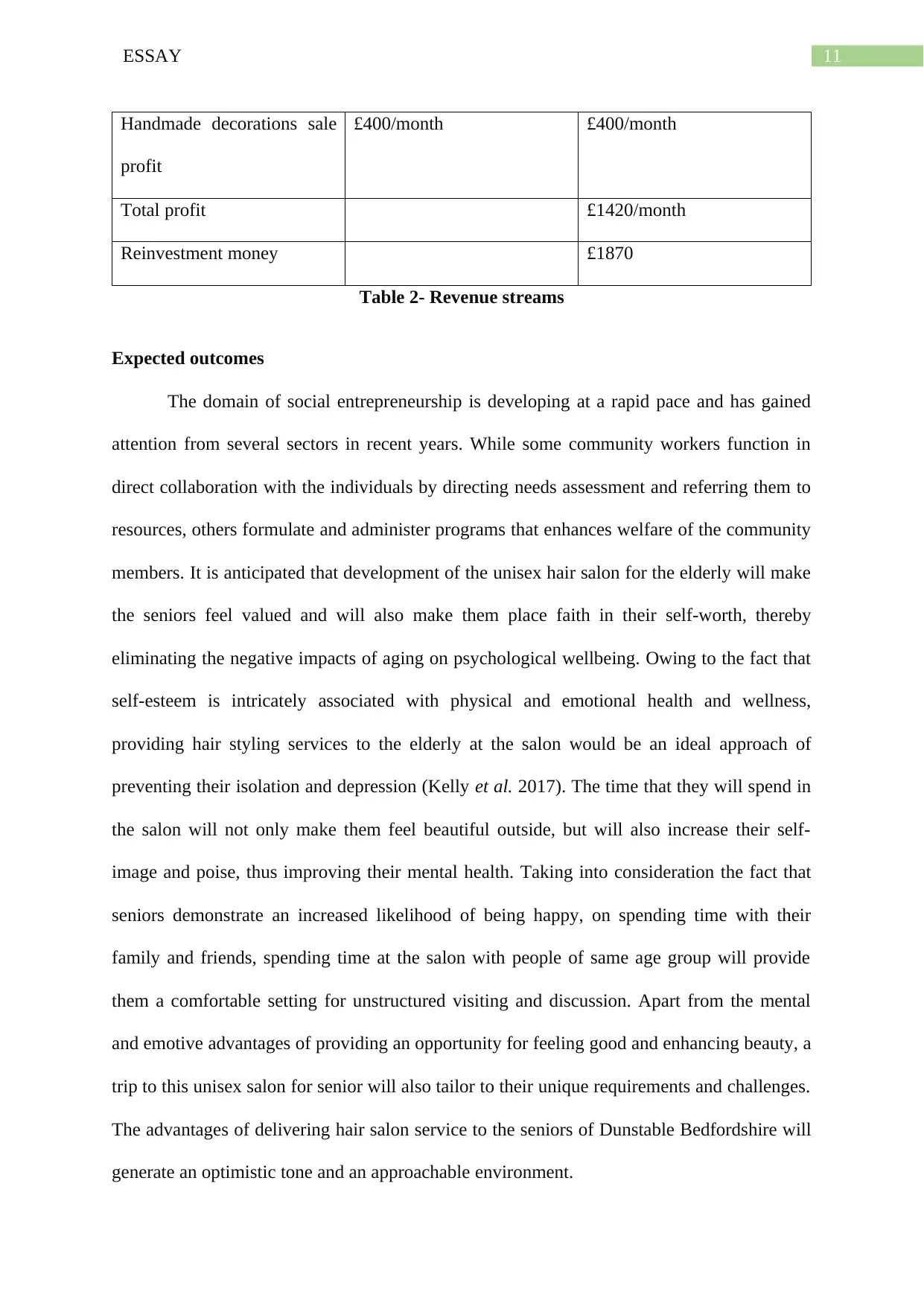
11ESSAY
Handmade decorations sale
profit
£400/month £400/month
Total profit £1420/month
Reinvestment money £1870
Table 2- Revenue streams
Expected outcomes
The domain of social entrepreneurship is developing at a rapid pace and has gained
attention from several sectors in recent years. While some community workers function in
direct collaboration with the individuals by directing needs assessment and referring them to
resources, others formulate and administer programs that enhances welfare of the community
members. It is anticipated that development of the unisex hair salon for the elderly will make
the seniors feel valued and will also make them place faith in their self-worth, thereby
eliminating the negative impacts of aging on psychological wellbeing. Owing to the fact that
self-esteem is intricately associated with physical and emotional health and wellness,
providing hair styling services to the elderly at the salon would be an ideal approach of
preventing their isolation and depression (Kelly et al. 2017). The time that they will spend in
the salon will not only make them feel beautiful outside, but will also increase their self-
image and poise, thus improving their mental health. Taking into consideration the fact that
seniors demonstrate an increased likelihood of being happy, on spending time with their
family and friends, spending time at the salon with people of same age group will provide
them a comfortable setting for unstructured visiting and discussion. Apart from the mental
and emotive advantages of providing an opportunity for feeling good and enhancing beauty, a
trip to this unisex salon for senior will also tailor to their unique requirements and challenges.
The advantages of delivering hair salon service to the seniors of Dunstable Bedfordshire will
generate an optimistic tone and an approachable environment.
Handmade decorations sale
profit
£400/month £400/month
Total profit £1420/month
Reinvestment money £1870
Table 2- Revenue streams
Expected outcomes
The domain of social entrepreneurship is developing at a rapid pace and has gained
attention from several sectors in recent years. While some community workers function in
direct collaboration with the individuals by directing needs assessment and referring them to
resources, others formulate and administer programs that enhances welfare of the community
members. It is anticipated that development of the unisex hair salon for the elderly will make
the seniors feel valued and will also make them place faith in their self-worth, thereby
eliminating the negative impacts of aging on psychological wellbeing. Owing to the fact that
self-esteem is intricately associated with physical and emotional health and wellness,
providing hair styling services to the elderly at the salon would be an ideal approach of
preventing their isolation and depression (Kelly et al. 2017). The time that they will spend in
the salon will not only make them feel beautiful outside, but will also increase their self-
image and poise, thus improving their mental health. Taking into consideration the fact that
seniors demonstrate an increased likelihood of being happy, on spending time with their
family and friends, spending time at the salon with people of same age group will provide
them a comfortable setting for unstructured visiting and discussion. Apart from the mental
and emotive advantages of providing an opportunity for feeling good and enhancing beauty, a
trip to this unisex salon for senior will also tailor to their unique requirements and challenges.
The advantages of delivering hair salon service to the seniors of Dunstable Bedfordshire will
generate an optimistic tone and an approachable environment.
⊘ This is a preview!⊘
Do you want full access?
Subscribe today to unlock all pages.

Trusted by 1+ million students worldwide
1 out of 17
Related Documents
Your All-in-One AI-Powered Toolkit for Academic Success.
+13062052269
info@desklib.com
Available 24*7 on WhatsApp / Email
![[object Object]](/_next/static/media/star-bottom.7253800d.svg)
Unlock your academic potential
Copyright © 2020–2025 A2Z Services. All Rights Reserved. Developed and managed by ZUCOL.





